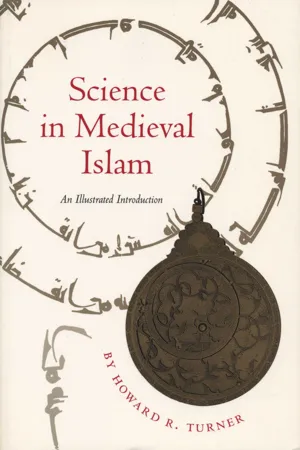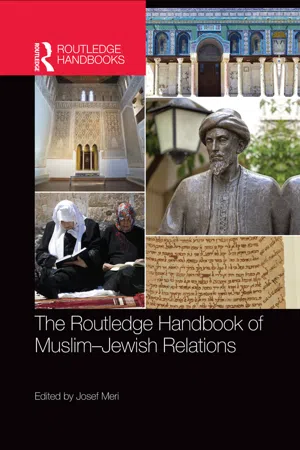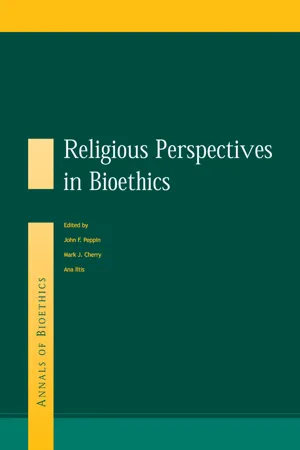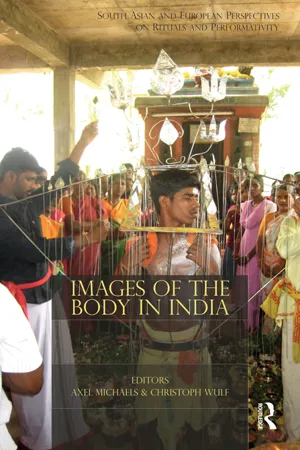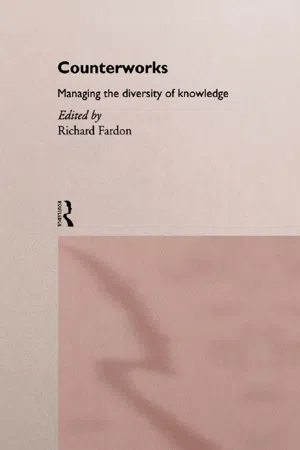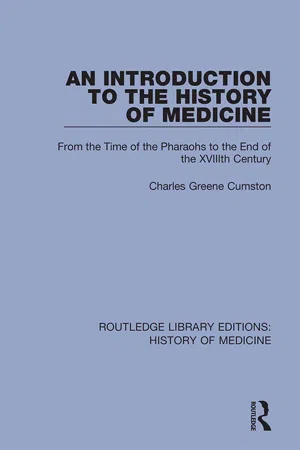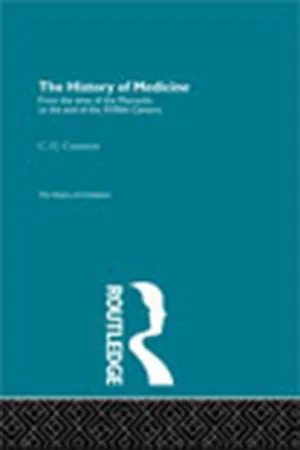History
Islamic Medicine
Islamic medicine refers to the medical practices and knowledge developed within the Islamic civilization, particularly during the medieval period. It was influenced by Greek, Roman, Persian, and Indian medical traditions and made significant advancements in areas such as pharmacology, surgery, and public health. Islamic medicine also played a key role in preserving and translating ancient medical texts, contributing to the development of medical knowledge in Europe.
Written by Perlego with AI-assistance
Related key terms
Related key terms
1 of 4
Related key terms
1 of 3
11 Key excerpts on "Islamic Medicine"
- eBook - ePub
- Ronald Ross Watson, Victor R Preedy, Sherma Zibadi(Authors)
- 2013(Publication Date)
- Academic Press(Publisher)
Chapter 3The History of Islamic Medicine at a Glance1
Zahra Tayarani-Najaran* , Nilufar Tayarani-Najaran† and Seyed Ahmad Emami‡ , *Department of Pharmacodynamics and Toxicology, School of Pharmacy, Mashhad, University of Medical Sciences, Mashhad, Iran ,† Department of Dental Prosthesis, School of Dentistry, Mashhad, University of Medical Sciences, Mashhad, Iran,‡ Department of Pharmacognosy, School of Pharmacy, Mashhad, University of Medical Sciences, Mashhad, IranIslamic Medicine refers to medicine developed in the medieval Islamic civilization. Islamic Medicine has an antecedent over twelve centuries both in the east (Iran, Iraq, Syria, Egypt, Turkey and India) and west sections (Andalusia, Morocco, Algeria, and Tunisia) of the geographic extent of the Islamic civilization. During the Islamic Golden Age many Islamic physicians made marvelous discoveries in all aspects of medicine and the notable Islamic scholars in the history of medicine were introduced. The establishment of hospitals as the major contribution of the Islamic Age to the history of medicine is also discussed in this chapter.Keywords
Afsharid era; Andalusia; Arabic medicine; Iranian medicine; Islamic civilization; Islamic Medicine; hospitals; Mongol invasion; Safavid era; Timurid era1 Introduction
In the history of medicine, Islamic Medicine or Arabic medicine refers to medicines developed in the medieval Islamic civilization and written about in Arabic, the lingua franca of the Islamic civilization. Despite these names, a significant number of scientists during this period were not Arab. Some consider the label “Arab-Islamic” as historically inaccurate, arguing that this label does not appreciate the rich diversity of Eastern scholars who have contributed to Islamic science in this era. Latin translations of Arabic medical works had a significant influence on the development of modern medicine, as did Arabic texts chronicling the medical works of earlier cultures. - eBook - ePub
- Lois N. Magner, Oliver J Kim(Authors)
- 2017(Publication Date)
- CRC Press(Publisher)
Early Western accounts of so-called Arabian medicine reflected the legacy of conflict rather than an analysis of Islamic Medicine as a component of a system of faith and a means of dealing with the universal problem of illness. For many European scholars, Arabian medicine was significant only in terms of the role it played in preserving Greek medical texts. Arabian medicine was understood as synonymous with Arabic medicine—Arabic being the language of learning throughout areas under Islamic control. Thus, Arabic texts need not have Arab authors; Jews, Persians, and Christians took part in the development of the Arabic medical literature.Written sources for the study of classical Islamic Medicine come from a geographic area stretching from Spain to India and a time span of some 900 years. Just as the term Chinese medicine is broadly used with respect to medical practice in the countries that came within the sphere of China’s influence, the term Islamic Medicine is used to designate the system of ideas and practices transmitted with the Arab conquests. Like Chinese medicine and Ayurvedic medicine, Islamic Medicine, also known as unani medicine (Greek-Islamic Medicine), is a living system still studied and practiced by traditional healers.Discussions of Arab achievements in science, medicine, and philosophy once focused on a single question: did the Arabs merely transmit Greek literature or did they make any original contributions? However, the question of originality is not really appropriate when applied to this era. During the Golden Age of Islamic Medicine, physicians and philosophers generally accepted the writings of the ancients as truth, example, and authority, to be analyzed, developed, and preserved. Having no attachment to the doctrine of originality, medieval scholars saw tradition as a treasure chest, not as an obstacle. However, scholars in the Islamic world had to find a means of peaceful coexistence with religious leaders who believed that it was only important to know the ideas of the prophet Muhammad, his immediate followers, and the Koran.References to the importance of health and wellbeing can be found in the Koran and other teachings associated with Muhammad. Indeed, it was said that the Koran was given to believers as a guide and a medicine that restored both spiritual and physical health. In a literal sense, the Koran could actually be taken as a medicine by writing a passage from the sacred book on a cloth, washing out the ink, and drinking the wash water. Fragments concerning medical lore culled from the Koran and the sayings and doings (Hadith - eBook - ePub
Science in Medieval Islam
An Illustrated Introduction
- Howard R. Turner(Author)
- 2010(Publication Date)
- University of Texas Press(Publisher)
9The best gift from Allah to mankind is good health. Everyone should reach that goal by preserving it for now and the future.MedicineOne of the hadith attributed to Muhammad, the statement above reflects the serious and sustained attention devoted by Islamic society to the life sciences. The heritage of knowledge absorbed by medieval Muslim physicians was indeed rich. It embraced the achievements of classical Greece and Rome as well as those learned from Syriac, Persian, and Indian sources.The Greeks conceived of four constitutional humors (melancholic, sanguineous, choleric, and phlegmatic), along with three functional fluids (arterial and venous blood and nervous fluid) and the spirits (vital, natural, and animal) that controlled the fluids. All these elements, in the proper balance, were essential for good health. They were spelled out in the writings of Hippocrates and, above all, in the basic teachings and elaborate theories of Galen, which dominated the formation of Muslim medical theory and practice.Greco-Roman medicine had come to define illness in general as a natural phenomenon within the humoral framework. Muslim physicians reasoned that the humors were profoundly influenced by life’s strains and stresses. It was thought that illness could be countered by utilizing the patient’s own systemic resources in helping along the processes of curing or healing. This kind of thinking was far removed from the notions of “evil spirits” or forces of magic so often connected with disease and treatment in the medieval West and elsewhere. Furthermore, such an approach was in certain ways implicit in Islam’s religious thought, and Muslim physicians applied it to every aspect of their own theory and practice.One of the Muslims’ greatest sources of practical information, used by both physicians and pharmacists, was De Materia Medica, written in the first century AD - Josef Meri(Author)
- 2016(Publication Date)
- Routledge(Publisher)
Jews could practice medicine in Ottoman courtly circles until as late as 1574, when a ferman ordered that a vacant position among the court doctors could be filled only by a Muslim. Interestingly enough, this was explained by the fact that Jewish physicians at court outnumbered Muslims. 52 Throughout the Middle Ages, medicine continued to form a bridge over divisions and to soften the intercommunal tensions and antagonisms in the Islamic Near East. No matter how important the influence of religious divides on the cultural climate and the social mood, it mattered little to the desperate patient whether the healer was Muslim, Christian, or Jewish, as long as he could, or was believed to be able to, heal the sick. 53 Such patient-doctor interfaith confidence was possible, above all, because the medical system that prevailed in the medieval Islamic Near East was impartial, universal, and free of theology. Despite the progressing radicalization of Islam from about the mid-thirteenth century on, the hostility toward the religious “other” did not cover the entire medical domain. 54 Within the Near Eastern medical culture, a fragment of a relatively neutral land remained, a particular “community of discourse” within which the Hippocratic-Galenic doctrine shaped common thinking on medicine, health, illness, pharmacology, and diet. Muslim-Jewish relations: medicine in Christian Europe The integration of Jewish physicians and intellectuals generally in Muslim society and culture had strong and lasting repercussions on Jews living in Christian Europe. This part of the chapter briefly describes how the medieval Jewish physicians’ close ties to Arabic medicine persevered in some Christian societies long after the real contact to Islamic society ceased to exist- eBook - ePub
- Mark Cherry(Author)
- 2013(Publication Date)
- Routledge(Publisher)
In recent years, Muslim religious scholars have produced legal and ethical responses to the majority of the questions raised by these developments. In major centers of Islamic learning like Cairo, Egypt, and Qumm, Iran, prominent scholars of Islamic law and ethics are engaged in providing ethical decision on all sorts of questions that have arisen in the last three decades (see, e.g., Assad, 1971; Giorgis, 1981). Before we begin to assess Islamic resources for modern reflection on the relationship between the professional and patient, let us understand Islamic tradition in its general outline. This information will enable the reader to grasp the adequacies and the inadequacies of Islamic tradition in providing solutions to contemporary problems in the biological sciences, medicine, nursing, and other modes of health care (Sachedina, 1996a, 1996c; Islamic Medical Wisdom, 1991; Plessner, 1974). II. Historical Background Islam, the last of the Abrahamic religions, literally means “submission to God’s will.” It was proclaimed by Muhammad (born 570 C.E.), the Prophet of Islam and the founder of Islamic public order in the seventh century C.E. in Arabia. The beginning of Islam in 610 C.E. was marked by a struggle to establish a monotheistic faith and create an ethical public order embodying divine justice and mercy. Muhammad as a statesman instituted a series of reforms to create his community, umma, on the basis of religious affiliation. Within a century following Muhammad’s death in 632 C.E., Muslim armies had conquered the region from the Nile in North Africa to the Oxus in Central Asia up to India. This phenomenal growth into a vast empire required an Islamic legal system for the administration of the highly developed political systems of the conquered Persian and Byzantine regions - eBook - ePub
Images of the Body in India
South Asian and European Perspectives on Rituals and Performativity
- Axel Michaels, Christoph Wulf(Authors)
- 2012(Publication Date)
- Routledge India(Publisher)
Instead it functioned as the specialized knowledge of an elite, qualified for healing illnesses. To this corresponded the shift in language from widely known Persian to Arabic, limited to a circle of insiders (cf. Alavi 2007, pp. 33–46). The use of Arabic also points to their close intellectual relation to the Islamic reform movement, with which they shared a drive towards the systematization of knowledge and also the distancing from Sufi practices considered superstitious, 6 like healing through amulets, the symbolism of numbers and the rituals based on the belief that the healing power of sacred persons, spaces or texts could be transferred through material means (dust of the grave of a saint, verses of the Qoran diluted in water etc.). It was this movement which was reinforced by the colonial power from the first decades of the 19th century. While medical practitioners in the early phase of the East India Company had still shared basic humoral assumptions with their Indian counterparts, which in turn had enabled a dialogue on appropriate ways of curing tropical diseases, but also on the proprieties of medical plants and herbs, this common tradition came increasingly under attack from the 1830s onwards. Two developments came together for this: in European medicine, illnesses were increasingly ascribed no longer to humoral imbalances or to miasmatic influences, but to germs, giving a new direction to research on medication. Parallel to this, the importance of the study of anatomy increased in the West, where it led to new developments in the field of invasive surgery (cf. Grmek 1999). The self-confidence which characterised this new generation of doctors, who described their field no longer as an art, but as a science, matched well with the general feeling of superiority evinced by the Anglicists and led to the establishment of a number of schools teaching Western medicine and to the foundation of the Indian Medical Service - eBook - ePub
Counterworks
Managing the Diversity of Knowledge
- Richard Fardon(Author)
- 2003(Publication Date)
- Routledge(Publisher)
As elsewhere in the world, patients tend to distinguish between ‘European’ practices—good for the treatment of acute problems for which a dose of penicillin may provide quick relief (so reinforcing the bio-medical view of disease as eliminable)—and Islamic Medicine, which they seek for what are perceived to be longer-term, chronic ailments, the more rounded treatment of which includes divining who, as well as what, is the causative agent of the apparently ineliminable affliction. But, in addition to this complementary distinction, people perceive overlapping areas of competence and medicines; and there is certainly no sense of either form of therapy being superior in all instances to the other. Instead, it is the skills of individual doctors that are ranked.A second perspective on this dispersal is the extraordinary variety of public roles played by the Muslim healers, who are well aware of this diversity. At one day-long session which I witnessed, the Muslim doctor, a Sharif called Khitamy, prescribed medicines, married a couple, negotiated a land dispute by phone, provided social counselling both to a woman and, later, her husband, whose marriage was under stress, and finished his short day in the clinic by rushing off to help some Somali refugees who had recently arrived in Mombasa. He and other Muslim healers in his network of masters and tutors also hold time-consuming public positions in party political branches, professional medical associations and Muslim welfare and education societies.Just as one can enter the coastal medical culture at any one of a number of points, say through ideas of bad death or the art of bone-setting, so one can grasp any one of these many roles held by an individual as, for that moment in time, being his most significant activity. At most, a Muslim healer is only ever part-time. But sometimes, during the long periods when he is involved in another duty or interest, he is not practising medicine at all. In this respect he is like many non-Muslim traditional healers and diviners who have reputations of greater or lesser worth and scale but who all, at some point, fit themselves into an array of other personas.How, then, do potential patients regard Islamic Medicine and its practitioners? The patients themselves do not appear over-concerned with defining a distinctively Islamic medical category. They are, however, concerned with the reputation of any particular practitioner who is recommended to them, along with a variety of others of different persuasions, as the malady proceeds. The network of recommenders and recommended not surprisingly consists almost entirely of coastal Muslims and comprises Arabs, Swahili, other African Muslims and some non-Muslims, including among these latter a few from up-country. It is through such a network that Muslim patients seek Muslim healers and that certain putative aspects of Islam reinforce the settings in which they meet. - eBook - ePub
Islam and Social Work
Culturally Sensitive Practice in a Diverse World
- Crabtree, Sara Ashencaen, Husain, Fatima(Authors)
- 2016(Publication Date)
- Policy Press(Publisher)
SIX
Muslim families and health
Medicine in historical Islam
Historically the Muslim world has enjoyed a very long and enlightened attitude towards health and healing, in which Persian and Hellenic medical knowledge provided a useful foundation for Muslim scholarship to develop into a rich repository of learning. For example, the celebrated centre of medical learning in Cairo held three large hospitals by the year 872 BCE . These were apparently built in a cruciform shape to hold separate wards. By 1284 in Cairo the Qalawun hospital set up by the Sultan of the same name was offering the following remarkably modern sounding healthcare:The mentally ill were kept apart from those with physical symptoms and men were housed separately from women. There were also separate units for patients with eye disorders, stomach complaints and those needing surgery. Hospital doctors by that stage had begun to specialise and the Qalawun records tell us that it employed physicians, surgeons and ophthalmologists, as well as administrators, nurses, accountants and orderlies. (Masood, 2009, p 88)The great Islamic cities of Baghdad and Cordoba were also the sites of many hospitals, which boasted a system of interns as well as teaching and library facilities. They supplied rudimentary nursing care, held well-stocked pharmacies and even ran outpatient services (Udwadia, 2001). Rassool (2000) refers to how hospitals’ wards were divided into those catering for specific maladies, such as infectious diseases and mental illness. Consequently, during the early medieval period, these centres of medical excellence were unparalleled throughout the civilised world, where in Europe the sick and destitute were reliant on the skills and charity of monks for succour and healing. - eBook - ePub
Technology, Tradition and Survival
Aspects of Material Culture in the Middle East and Central Asia
- Richard Tapper, Keith McLachlan(Authors)
- 2004(Publication Date)
- Routledge(Publisher)
The available evidence suggests that, in essence, the theoretical basis of Arabic medicine remained Greek, but certain special areas were developed by the Arabs to a much larger extent, for example, ophthalmology, surgery and pharmacology. Even so, it was Greek humoral theory which formed the framework and the limits of all Arabic medical thinking, observation and discovery. We know that the early Abbasid caliphs of Baghdad invited Indian physicians and scholars to their court, rewarded them generously and held them in high esteem. Nevertheless, Indian medicine and the Indian world-view never really caught on with the Arabs, and they remained committed to Greek medicine and Greek philosophy. At their hands, Greek medicine became highly organized and systematized to the ultimate degree. This feature is best exemplified in Ibn Sina’s monumental work, al-Qanun fi’l-Tibb, which brought together the whole of Arabic medical theory and practice, and was the medical bible for generations of doctors and scholars. 1 Even today, it is a basic textbook for training in the so-called Unani Tibb of the Hamdard National Institute in Karachi, where doctors are taught traditional Arabic medicine. Within the confines of humoralism, Graeco-Arabic medicine was a rational system, remarkably free of magic, superstition and religious influences. A good illustration of this last point is provided by the frequent prescriptions for wine found in Arabic medical books. Indeed, there was a well-established tradition for the use of wine in disease, presumably stemming from the Greeks - eBook - ePub
An Introduction to the History of Medicine
From the Time of the Pharaohs to the End of the XVIIIth Century
- Charles Greene Cumston(Author)
- 2018(Publication Date)
- Routledge(Publisher)
CHAPTER XIIIIslamic Medicine
For a long time it was maintained that the Arabs were merely servile copyists of the Greeks, and even that they caused a delay in the evolution of medical science. This is a mistaken opinion. At the time when the Arabs appeared in the Orient, Greek science was in complete decadence, and the practice of magic reigned supreme. Not only did the Arabs save the Greek treasures from the irredeemable loss to which but for them they had been doomed, but they developed the taste for scientific studies, both in the East and in the West, by popularizing and commenting upon the Greek works. Had they merely been content with collecting Greek science and transmitting it to Europeans, that would alone have been a great glory to them. But they did better still, for in the arts, as in the sciences, they did original work.It is perfectly true that at the base of Arabian civilization we find Graeco-Byzantine civilization, but very soon the Arabian character asserted itself and all Arabian works showed an originality which distinguishes them from the productions of former civilizations. “The Arabs,” says Humboldt, “drove back the barbarism which had already existed in Europe for two centuries … ; they went back to the eternal sources of Greek philosophy; they did not stop at saving the treasure of acquired knowledge; they increased it and opened up new routes for the study of nature.”Up to the last twenty-five years Islamic Medicine and the Arabian physicians were only known by Latin translations of their works which, according to the opinion of all historians, are very defective. The studies of Dr. Lucien Leclerc in the history of Islamic Medicine are, however, epoch-making, and others, without particularly concerning themselves with medicine, have shown the great merit of the Arabian physicists and have proved that their civilization was not plagiarism. Among these should be mentioned Dr. Gustave Lebon, who has written a remarkable work on Arabian civilization, while of recent years Professor G. Colin has written a number of very interesting works and made several translations, especially of Avenzoar ; Professor Guibues has recently translated the book entitled The Art of Treatment, by Najm ed-Din Mahmud; nor should the important contributions by Dr. H. Renaud and Prof. E. G. Browne’s Arabian Medicine - eBook - ePub
- C.G. Cumston(Author)
- 2013(Publication Date)
- Routledge(Publisher)
CHAPTER XIII Islamic MedicineFor a long time it was maintained that the Arabs were merely servile copyists of the Greeks, and even that they caused a delay in the evolution of medical science. This is a mistaken opinion. At the time when the Arabs appeared in the Orient, Greek science was in complete decadence, and the practice of magic reigned supreme. Not only did the Arabs save the Greek treasures from the irredeemable loss to which but for them they had been doomed, but they developed the taste for scientific studies, both in the East and in the West, by popularizing and commenting upon the Greek works. Had they merely been content with collecting Greek science and transmitting it to Europeans, that would alone have been a great glory to them. But they did better still, for in the arts, as in the sciences, they did original work.It is perfectly true that at the base of Arabian civilization we find Graeco-Byzantine civilization, but very soon the Arabian character asserted itself and all Arabian works showed an originality which distinguishes them from the productions of former civilizations. “ The Arabs,” says Humboldt, “ drove back the barbarism which had already existed in Europe for two centuries … ; they went back to the eternal sources of Greek philosophy ; they did not stop at saving the treasure of acquired knowledge ; they increased it and opened up new routes for the study of nature.”Up to the last twenty-five years Islamic Medicine and the Arabian physicians were only known by Latin translations of their works which, according to the opinion of all historians, are very defective. The studies of Dr. Lucien Leclerc in the history of Islamic Medicine are, however, epoch-making, and others, without particularly concerning themselves with medicine, have shown the great merit of the Arabian physicists and have proved that their civilization was not plagiarism. Among these should be mentioned Dr. Gustave Lebon, who has written a remarkable work on Arabian civilization, while of recent years Professor G. Colin has written a number of very interesting works and made several translations, especially of Avenzoar ; Professor Guibues has recently translated the book entitled The Art of Treatment , by Najm ed-Din Mahmud ; nor should the important contributions by Dr. H. Renaud and Prof. E. G. Browne’s Arabian Medicine
Index pages curate the most relevant extracts from our library of academic textbooks. They’ve been created using an in-house natural language model (NLM), each adding context and meaning to key research topics.
Explore more topic indexes
Explore more topic indexes
1 of 6
Explore more topic indexes
1 of 4


